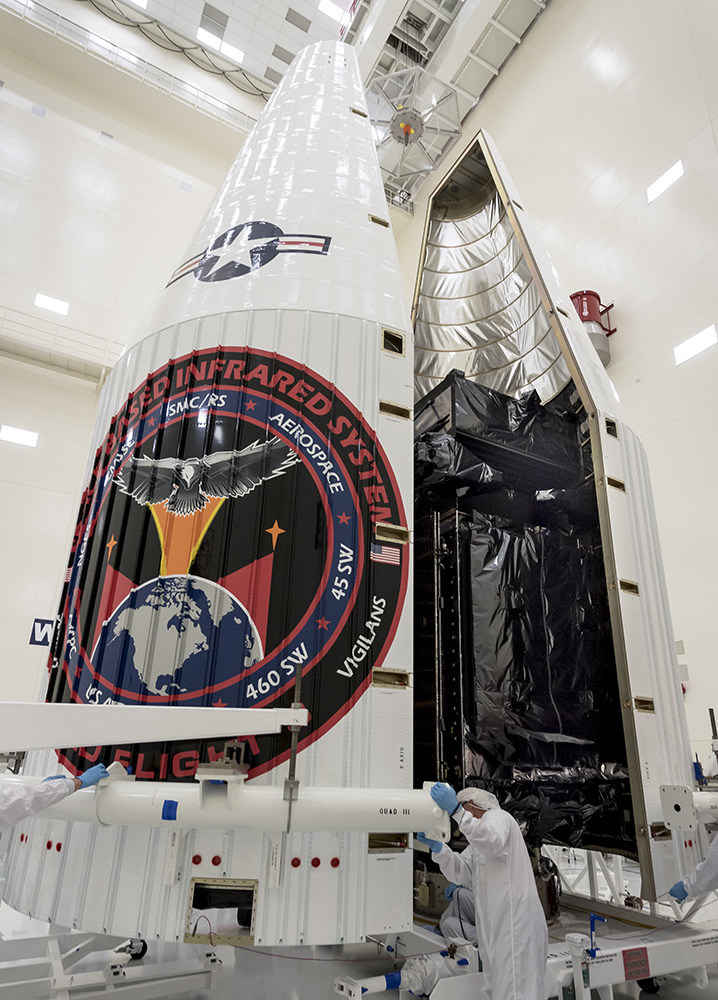Missile-Warning SBIRS GEO-3 Looking Good for Jan. 19 Launch

WASHINGTON — The U.S. Air Force's next missile-warning satellite is set to launch from Florida Jan. 19, mission leaders said during a Tuesday teleconference with reporters.
The military's third Space Based Infrared System Geosynchronous satellite, or SBIRS GEO-3, is checking out, and while there are still a few operational and launch readiness reviews to perform, there do not appear to be any issues that might delay the launch, officials said.
"This is the first national security space mission out of eight planned for this calendar year, and it helps honor the 70th anniversary of the Air Force," said Col. Kent Nickle, the launch mission director. [The Most Dangerous Space Weapons Concepts Ever]

The launch of the Lockheed Martin-built satellite was originally scheduled for last October but was pushed back when a supplier told the company they had an issue on an unrelated satellite with one of their engine components, a part that was also used aboard SBIRS.
After a review, however, no problems were found with the engine onboard the SBIRS craft. Col. Dennis Bythewood, the director of the Remote Sensing Systems Directorate for the Air Force's Space and Missile Systems Center, confirmed that the delay had no impact on the missile-warning mission.
"We feel very comfortable that we've got a good engine on GEO Flight-3 and that it's ready to fly," said Bythewood, who just took over as director of remote sensing in December.
The satellite will augment the two existing SBIRS satellites in orbit, as well as the older Defense Support Program systems. Bythewood said the launch "will provide faster and more accurate missile warning to the warfighter."
Get the Space.com Newsletter
Breaking space news, the latest updates on rocket launches, skywatching events and more!
The SBIRS constellation provides better detection of a missile's point of origin compared to DSP, as well as better prediction of where the missile might impact, Bythewood said. SBIRS also can detect dimmer engine burns, helping to track a wider-range of ballistic missiles.
That helps a great deal with theater security, where the military might not be trying to track a nuclear weapon so much as smaller rockets headed towards troops on the ground or a military base.
Bythewood noted that there are hundreds of ballistic missiles within range of U.S. troops worldwide.
"When the system was originally designed in a Cold War era, we were really worried about the Soviet Union and its allies," he said, adding that it gave the U.S. a specific geographic region to focus on.
"In today's world, especially in the last 20 years, the proliferation of missiles outside of that concentrated area has grown demonstrably," he continued. "What SBIRS brings in capability … is the ability to find dimmer targets with shorter burn times, and those are representative of the tactical threats we see both in Asia and in the Middle East today."
The satellite will launch from Cape Canaveral Air Force Station, Florida, aboard a United Launch Alliance Atlas 5 rocket. A 40-minute launch window opens at 7:46 p.m. EST.
This will be the first of 12 planned launches for ULA this year.
The first and second SBIRS GEO satellites were launched in 2011 and 2013, respectively. A fourth SBIRS GEO satellite is scheduled for launch Nov. 9.
Construction is also underway on a fifth and sixth SBIRS satellite, expected to be delivered in 2020 and 2021, Bythewood said.
In addition to the dedicated geostationary SBIRS satellites, SBIRS payloads are also flying in highly elliptical orbits as hosted payloads on classified satellites.
Northrop Grumman built the sensor suite that will serve as the heart of the satellite. Bythewood said it was delivered to Lockheed Martin in September 2014, and the company in turn delivered the satellite to the U.S. Air Force in August 2016.
The total cost of building and launch SBIRS GEO-3 is estimated at $1.2 billion.
This story was provided by SpaceNews, dedicated to covering all aspects of the space industry.
Join our Space Forums to keep talking space on the latest missions, night sky and more! And if you have a news tip, correction or comment, let us know at: community@space.com.

Phillip Swarts covered the military, national security and government contracting in space for Space News from 2016 to 2017. A master's graduate of the Medill School of Journalism at Northwestern University, Swarts's work can also be found at The Washington Times and Air Force Times. More recently, he has worked as a teacher for the Arlington Public School District.










